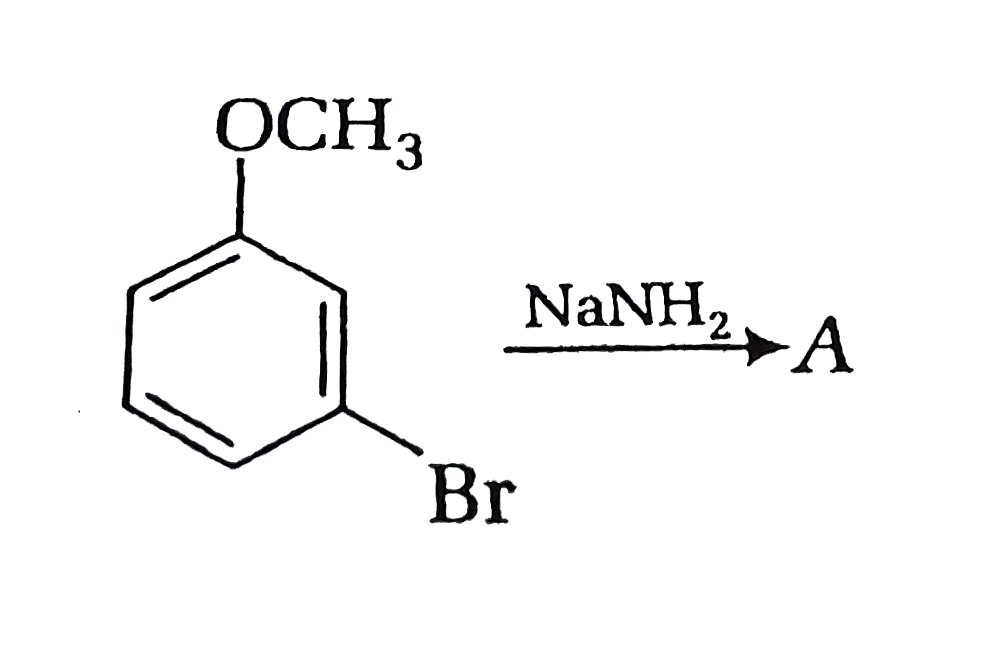CH3CH3∣C∣CH3−Br KOH (alcoholic) −−−−−−−−−−−−→Δ(A)HBr/R2O2−−−−−−→(B)(major)
(B) is
CH3−CH3∣C∣H−CH2−Br
CH3−CH3∣C∣Br−CH2
CH3−CH3∣C∣CH2−Br−OH
CH3−CH2−H∣C∣CH3−Br
The correct Answer is:A
Step by step video solution for CH_(3) overset(CH_(3))overset(|)underset(CH_(3))underset(|)(C) -Br overset(" KOH (alcoholic) ")underset(Delta)(to) (A) overset(HBr//R_(2)O_(2))(to) underset(("major"))((B)) (B) is by Chemistry experts to help you in doubts & scoring excellent marks in Class 12 exams.
Updated on:21/07/2023Topper's Solved these Questions
- HALOALKANES AND HALOARENES Book:AAKASH INSTITUTE ENGLISHChapter:HALOALKANES AND HALOARENES Exercise:ASSIGNMENT SECTION - B
Explore 25 Videos
- HALOALKANES AND HALOARENES Book:AAKASH INSTITUTE ENGLISHChapter:HALOALKANES AND HALOARENES Exercise:ASSIGNMENT SECTION - C
Explore 39 Videos
- HALOALKANES AND HALOARENES Book:AAKASH INSTITUTE ENGLISHChapter:HALOALKANES AND HALOARENES Exercise:EXERCISE
Explore 40 Videos
- GENERAL PRINCIPLES AND PROCESSES OF ISOLATION OF ELEMENTSBook:AAKASH INSTITUTE ENGLISHChapter:GENERAL PRINCIPLES AND PROCESSES OF ISOLATION OF ELEMENTSExercise:Try Yourself
Explore 33 Videos
- HYDROCARBONSBook:AAKASH INSTITUTE ENGLISHChapter:HYDROCARBONSExercise:Assignment(Section - C) (Previous Years Questions)
Explore 60 Videos
Similar Questions
Which of the following is least reactive towards SN2 mechanism ?
View SolutionIdentify A and predict the type of reactions

View SolutionWhich of the following is an example of aryl alkyl halide ?
View SolutionMatch the following from column I to column II
Column IColumn IIMalachiteFeSphaleriteAgHorn silverZnChromiteCu
View SolutionH3C−C≡CHH2O,H4SO4−−−−−−−→HgSO4intermediateA→productB
View SolutionWrite the IUPAc name of the following compound :
(a) CH3−CH2−CH3∣CH−CH=CH−CH2−CH3
(b) CH3−CH2−CH3∣CH−CH2−CH3∣CH−CH∣CH2∣CH2∣CH−CH3∣CH3−CH=CH3∣C−CH3
View SolutionWrite the structures of monomers of the following polymers
(a) ⎡⎢ ⎢⎣−CH2−CH3∣C∣Ph−CH2−CH∣CN−⎤⎥ ⎥⎦n
(b) ⎡⎢ ⎢⎣−CH2−Cl∣C∣Cl−CH2−Cl∣C∣Cl−⎤⎥ ⎥⎦
( c) ⎡⎢ ⎢⎣−CH2−CH3∣C∣Ph−CH2−CH3∣C∣CN−⎤⎥ ⎥⎦.
View SolutionIn how many of the following reactions regioselectivity can be observed.
(I). CH3−CH3∣CH−CH2−Ohcon H2SO4−−−−−−−→Δ
(II). CH3−CH2−CH2−C∣OHH2Al2O3−−−→Δ
(III). CH3−CH3∣C−CH2−CH2−CH3alc.KOH−−−−−→Δ
(IV). CH3−CH2−C∣BrH−CH2−CH3Alc.KOH−−−−−→Δ
View SolutionCH_(3)-underset(CH_(3))underset(|)overset(CH_(3))overset(|)(CH)-overset(KMnO_(4))to (A) overset(H^(+))underset(Delta)to (B) overset(HBr) underset(RO OR) to (C) Product (C) in the above reaction is:
View SolutionCH3−CH3∣C∣CH3−C∣BrH−CH3nderset(Δ)EtOH−−−→(A)
Major product (A) is:
View SolutionCH3−CH3∣C∣OH−CH3∣C∣NH2−CH3HNO2−−−→Δ?
View SolutionThe major product of the following reaction is :
CH3C∣BrHCH2C∣BrHCH2CH3KOH,CH3OH−−−−−−−−−−−→heat
View SolutionCH_(3) overset(CH_(3))overset(|)underset(CH_(3))underset(|)(C) -Br overset(" KOH (alcoholic) ")underset(Delta)(to) (A) overset(HBr//R_(2)O_(2))(to) underset(("major"))((B)) (B) is
View Solutionनिम्नलिखित यौगिकों के IUPAC नाम लिखिए-
(a) CH3−Br∣CH−Br∣CH−COOC2H5
(b) (CH3)3C.CH2.CH2Cl
(c) CH3−CH2−CH∣Br−CH∣CH3−CH3∣C∣CH3−CH3
(d) CH3−CH2−CH∣Br−CH3∣C∣CH3−CH2Cl
View SolutionCH3−CH2−BrAlco. KOH−−−−−→ΔBHBr−−→CNa/ether−−−−−→D
The compound D is:
View SolutionCH_(3)-underset(CH_(3))underset(|)overset(Br)overset(|)C-CH_(3) underset("-HBr")underset(Delta)overset(Alc. NH_(3))to Y. Y is this reaction is ________ .
View Solution
